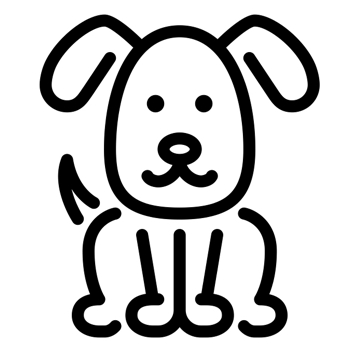Corgipoo

A small breed with a sturdy body and short legs, the Corgipoo was created by mixing the popular Miniature Poodle with the Welsh Corgi. A fun little dog, this breed loves to be right in the middle of things and craves human companionship.
Some (though not all) Corgipoos are hypoallergenic and often do not shed much. Their sweet nature and intelligence ensures that they are easy dogs to train, though there is the potential for them to be strong-willed, particularly if they inherit more of the Corgi personality genes.
About & History
A delightful little cross between the Corgi and Miniature Poodle, the Corgipoo, or Corgidoodle, is a real showstopper. Within the designer dog mix of crossbreeds, the Poodle features in many dog combinations thanks to its hypoallergenic qualities, intelligence and good-nature. While the Corgi may not be used as often in the creation of hybrid breeds, this social and affectionate dog is a sensible choice.
The Corgi used to create a Corgipoo may be either the Cardigan Welsh Corgi or the Pembroke Welsh Corgi. If the Pembroke variety is used in place of the Cardigan, it will result in a slightly smaller Corgipoo with less potential for coat colour variety. Despite their small stature, Corgis have historically been used as working dogs that would drive cattle on by nipping at their heels and chasing them. The Pembroke Welsh Corgi, who hails from Wales, is thought to have been in existence for around 1,000 years, while the Cardigan Welsh Corgi is thought to be even older.
Miniature Poodles were developed from the Standard Poodle and have traditionally been used as companion dogs. Despite their association with France, Poodles are actually believed to come from Germany and are thought to have originally been employed as duck hunters.
It is impossible to know when and where the very first Corgi and Miniature Poodle were bred together, but it likely occurred several decades ago. Their popularity has been growing steadily ever since, particularly in the USA.
Appearance
Predicting the appearance of a hybrid dog can be a real challenge and puppies may look physically more like either parent. While many Corgipoos will look like a good mix of each parent breed, some will take more after one side than the other. As a general rule, Corgipoos will have quite domed skulls, brown, almond-shaped eyes and ears that will either stand erect or flop forward endearingly. Their muzzle is relatively small and ends in a moderately sized black nose. Their body is short, as are their limbs, and their overall shape tends to mirror that of the Corgi more than the Poodle.
The coat of the Corgipoo is dense, medium in length and may have a slight wave or curl to it. It is a double-coat and the inner coat is soft and woolly. The fur colour can be black, white, red, brown or grey and many dogs will be bi-colour or tri-colour with patches and other markings. Typical adult Corgipoos will stand between 25cm-30cm and weigh anything from 5.5kg to 12kg.
Character & Temperament
A wonderful family pet, the Corgipoo gets on well with people of all ages and is a social little chap. They are mischief makers that enjoy playing with the children and typically show a lot of affection. They remain loyal to their family – though can become over-attached. An over-reliance on humans may result in separation anxiety in later life, so should be discouraged.
The Corgipoo would not make a good watch dog or guard dog, as they are not hostile or territorial at all. They will often greet unexpected guests warmly and welcome strangers with open paws!
A stubborn streak is possible, and Corgipoos may act out if they are bored or lack training. There can be a tendency to treat them like pampered children; carrying them around and allowing them on furniture and beds. Despite their small size and undeniable cuteness, it is essential to treat Corgipoos like the dogs that they are to ensure they develop into well-rounded and well-adjusted pets.
Trainability
Very intelligent (as are most cross-breeds that include the Poodle), the Corgipoo is highly trainable and loves to be challenged. They are fun-loving and eager to please – both traits that add to their training suitability. Any stubbornness should be stamped out early on in training, ensuring they understand that only positive behaviour is rewarded and encouraged.
As with most breeds, the earlier in the puppy’s life that training starts, the higher the chance of success. Introducing a consistent training programme and starting their sociali sation as soon as they arrive in their new home is critical.
Health
Analysing the information we have from their parents (the Corgi and Miniature Poodle) there are certain health conditions that we can predict will likely affect the Corgipoo more than the average canine. These include:
IVDD
IVDD stands for Intervertebral Disc Disease and is a spinal disease that results from disc herniation and spinal impingement. Affected dogs tend to be in a lot of pain and may walk gingerly or hunch over. Panting and shivering are also commonly seen. In cases where the spine is badly affected, a dog’s ability to walk and maintain a normal posture may be affected.
A CT scan under a general anaesthetic is the preferred method of diagnosis. In mild cases, conservative management that consists of strict rest and pain relief may be trialled. In more severe cases, spinal surgery is the only option that can offer a good prognosis.
Legg Calves Perthes Disease
This is a disease that occurs when the head of the long bone of the hind limb (femur) degenerates. This results in an improper hip joint and inevitable osteoarthritis and pain. Dogs may hold the affected leg off the ground or limp on and off.
There is often an obvious muscle wastage on the affected side, meaning the dog’s muscles look asymmetrical. X-rays can definitively identify the condition. Surgery to remove the affected portion of bone is typically advised, followed by rehabilitation and intense physiotherapy.
Patellar Luxation
The patella is also known as the knee cap and when the knee cap does not sit in the correct position all of the time, which is described as patellar luxation. There are several grades of this condition and dogs are affected to varying degrees. Usually, small breeds are over-represented and many dogs are affected in both knees.
While some dogs’ symptoms are confined to the odd hop now and then, others will have a continuous lameness with accompanying arthritis and pain. Orthopaedic surgery can be used to repair the joint, although mild cases can be managed with conservative therapy – e.g. maintenance of a lean body weight and the use of anti-inflammatories when needed.
Pancreatitis
An inflamed pancreas can result in a very poorly dog and may even result in death in extreme cases. Symptoms can include sudden vomiting and diarrhoea, a reduced appetite and signs of abdominal pain including a hunched posture and stretching. Though not every case of pancreatitis has a trigger, often feeding dogs human food and very fatty foods can trigger a bout.
Most affected dogs will need at least a few days in hospital where they can receive intravenous fluid therapy, strong pain relief and other medications, such as anti-nausea and antacid medicines. As pancreatitis can recur, many dogs will be maintained on a low-fat diet for life.
Exercise and Activity Levels
Though small in stature, the exercise needs of the Corgipoo should not be forgotten and they should receive about 30-40 minutes of outdoor exercise each day. A few short walks a day is preferable to one long hike, owing to their short limbs.
They also need a good amount of mental stimulation to keep their brain ticking over. They enjoy solving doggy puzzles, running agility courses and playing games, such as Flyball and 'Find It' where you hide treats or toys for them to find.
As the Corgipoo can be quite a clingy breed, it is not recommended to leave them outdoors, unsupervised for prolonged periods. This is particularly true if they are under-exercised, as they will likely start to develop nuisance behaviours, such as soil digging or incessant barking.
Grooming
Grooming requirements can vary from individual to individual, though most will shed very little and many retain the hypoallergenic qualities of their Poodle parent. Depending on fur length and texture, brushing may need to be carried out daily or every few days.

